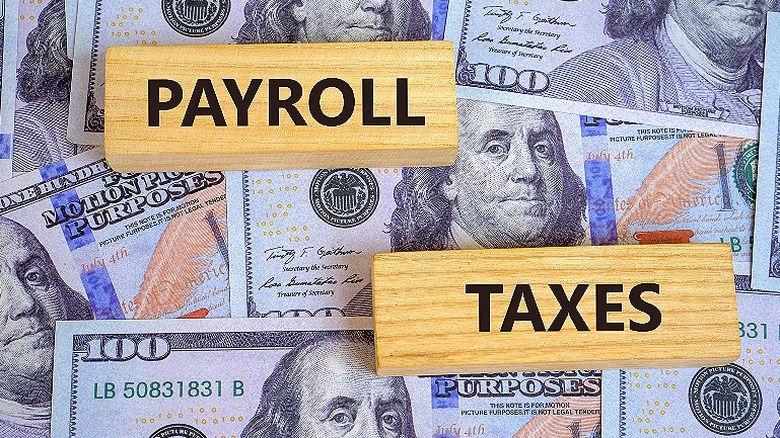Why FICA Taxes Are Taken Out Of Your Paycheck
Looking at the line-item deductions on your paycheck, you might have wondered what exactly FICA is, and why it's taking money out of your earnings. FICA is an acronym for the Federal Insurance Contributions Act, a federal payroll tax law dating back to 1935, the same year the Social Security Act was passed.
There's a close relationship between these two laws, as FICA was passed to collect income-based contributions to fund the country's newly established Social Security program, which, as you know, provides benefits for retirees, individuals with disabilities, and children. Thirty years later, when the Medicare program was established in 1965, FICA was expanded to collect contributions for that program as well.
Since 1990, FICA taxes have totaled 15.3%, which is split between employee and employer, so 7.65% paid by each. With this said, for self-employed workers, they pay the full 15.3%. (These are the most important tax breaks you need to know.)
How FICA breaks down
As noted, the amount of FICA taxes taken out of your paycheck is 7.65%. From this, 6.2% goes to Social Security and 1.45% goes to Medicare. Your employer pays the same amounts, which brings the total FICA to 15.3%. In 1990, when this FICA rate was first established, it only applied to the first $51,300 of a person's gross earnings. This ceiling has gone up each year since. In 2024, it was the first $168,600, and in 2025, it will be the first $176,100.
Meanwhile, people who work as freelancers, independent contractors, or who are otherwise self-employed must pay the entire 15.3% themselves, which breaks down to 12.4% for Social Security and 2.9% for Medicare. This is why tax experts advise self-employed workers to set aside 25% to 30% of every paycheck for their taxes, so that they're not caught short come tax time.
To calculate your FICA per paycheck, simply multiply .0765 by your gross earnings. For example, if your biweekly gross pay is $2,500, $191.25 of your paycheck will be taken out to pay for FICA taxes. For self-employed taxpayers, multiply instead by 0.153. (These are some of the most important tax breaks you need to know.)
Factors that impact FICA
The Social Security Administration uses the national average wage index (AWI) to compute what adjustments need to be made to Social Security benefits and contributions (i.e., FICA), in order to accurately "reflect the general rise in the standard of living that occurred during [a person's] working lifetime." This is why the threshold for gross pay for FICA has gone up every year since 1990. As mentioned earlier, in 2025, the 7.65% FICA tax rate will apply to the first $176,100 of a person's earnings, an increase of $7,500 or 4.4% from 2024. Note that this is actually 0.8% lower than the increase from 2023 to 2024.
It's important to note that this wage ceiling only applies to Social Security; there isn't a cutoff for FICA contributions to Medicare. Further, once a person earns $200,000 in a particular year, their Medicare contribution obligation actually increases for the rest of that year. Starting with the pay period in which an employee's taxable wages reach $200,000, their employer is required to withhold an additional 0.9% of their gross pay for the rest of that calendar year. (Check out Social Security rules that can boost your monthly benefits.)


